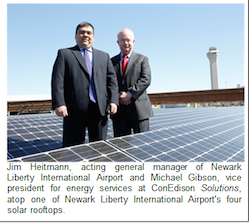This week, ConEdison Solutions and the Port Authority of New York & New Jersey unveiled one of four new solar installations that will produce clean energy at Newark Liberty International Airport. The 3,200 solar panel installation covers 62,000 square feet and will produce 817,000 kilowatt hours of electricity each year. This solar array marks the first solar power installation at any airport buildings operated by the Port Authority throughout the region.
 “The Port Authority is committed to implementing environmental programs we view as vital to our airports and other facilities,” said Port Authority Director of Environment & Energy Programs Christopher Zeppie. “Solar panels atop the roofs of buildings at Newark Liberty are an innovative way to make use of little used space to help reduce the agency’s carbon footprint while also saving money and increasing resiliency.”
“The Port Authority is committed to implementing environmental programs we view as vital to our airports and other facilities,” said Port Authority Director of Environment & Energy Programs Christopher Zeppie. “Solar panels atop the roofs of buildings at Newark Liberty are an innovative way to make use of little used space to help reduce the agency’s carbon footprint while also saving money and increasing resiliency.”
By utilizing solar power as an energy source, Newark Liberty International Airport anticipates an electricity savings of approximately $60,000 per year.
“Earth Week is the ideal occasion to recognize Newark Liberty International Airport for its outstanding commitment to sustainability,” said Michael W. Gibson, Vice President of ConEdison Solutions. “The Port Authority of New York & New Jersey is setting an excellent example for airports nationwide and around the world.”
Officials visited a 152-solar panel installation on the roof of Building 121, an AirTrain Newark electrical substation. The other three solar sites include a 312-panel project on an AirTrain Newark maintenance building, a 585-panel installation on a Port Authority maintenance building, and a 2,145-panel site on a multi-tenant cargo building.
To educate travelers and other guests about the benefits of the multi-site solar initiative, the airport will soon introduce colorful, interactive informational kiosks at Terminal B that will provide information about solar power and this initiative at Newark Liberty. Kiosks also will update visitors on the amount of power that has been generated during a particular day and during the current month and year.







 uld be a point of pride that Hawaii has the highest solar per capita in the country, it shouldn’t give us any reason to slow down,” said Jon Yoshimura, a Hawaii spokesperson for
uld be a point of pride that Hawaii has the highest solar per capita in the country, it shouldn’t give us any reason to slow down,” said Jon Yoshimura, a Hawaii spokesperson for 

